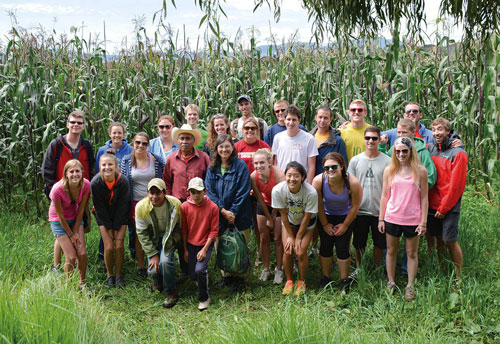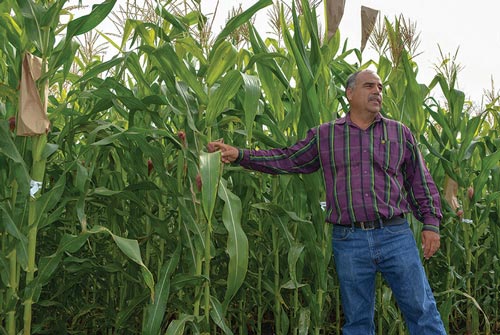
On 9 August CIMMYT-El Batán welcomed a group of 22 students and three teachers from the University of Wisconsin for a week-long stay. The students are enrolled in the university’s course for a Global Health Certificate, which introduces students to a preventive, population-level, interdisciplinary approach to health promotion. According to organizers, the trip to CIMMYT served to “open the eyes of the students to the importance of agriculture and nutrition.”
During the last six years, Dr. Sherry A. Tanumihardjo has visited CIMMYT with students to expose them to the realities of Mexican maize and wheat production systems, as well as how the Center’s research is helping smallholder farmers increase their productivity and improve their livelihoods. During the program’s first day, CIMMYT specialists presented the work being done at the Wellhausen-Anderson Plant Genetic Resources Center and the Seeds of Discovery initiative, as well as the objectives and strategies being pursued by the Maize, Wheat and Conservation Agriculture programs.
Genetic Resources Director Dr. Kevin Pixley led a discussion to help the students make sense of the different areas seen during the day and how they all work together to fulfill CIMMYT’s mission. On their second day, the group traveled to the Tlaltizapán experiment station, where Dr. Oscar Bañuelos explained the work being done in the Tripsacum ex situ conservation garden, while Thanda Dhliwayo described in detail the work that is being conducted with biofortified maize.
Later, the group travelled to Cuernavaca to learn about the work being done to reduce Mexico’s obesity and malnutrition problems by Dr. Salvador Villalpando, director of the National Institute of Public Health. On Wednesday, the group continued their cultural tour, visiting the National Museum of Anthropology and the Mexico City Historic Center. Previously, María Elena Campos had taken them to the pyramids in Teotihuacán so the visitors could get a better sense of Mexico, its origins and its rich history. The day ended at the Palace of Fine Arts (Palacio de Bellas Artes), where everyone had a chance to relax and enjoy a production of the Ballet Folklórico de México.

On Thursday, the students visited the Toluca experiment station and were welcomed by Fernando Delgado, senior station superintendent. After briefly explaining what CIMMYT does in Toluca, Delgado took them to meet local farmers, where the students had the opportunity to watch, listen and talk to some of the people that CIMMYT serves, and to gain a better understanding of their problems and needs.
On their last day, the group visited the Santa Catarina field with Arturo Reyes Ramírez and learned about the nixtamalization process from Estela Flores. The experience had a strong impact on the students, who learned first-hand about Mexican maize production and consumption processes, from the fields to the dining table. They left with a greater understanding of how important maize is, not only as food, but also as a cultural phenomenon. Visits like this raise awareness about the importance of the research and work being done at CIMMYT. The students from the University of Wisconsin take home a powerful memory of the work that CIMMYT does to help the world’s poor farmers.
 Capacity development
Capacity development 
